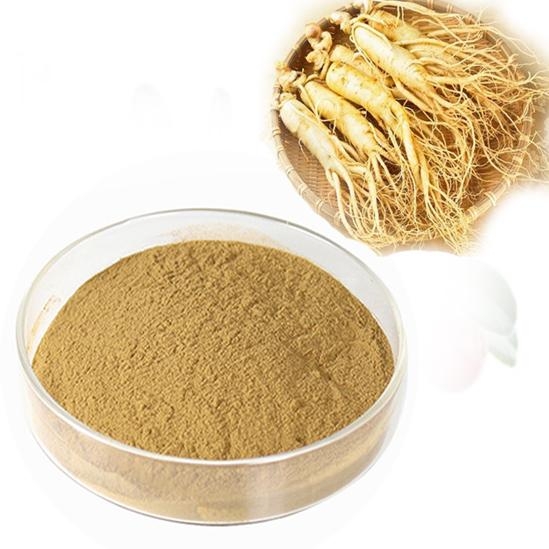
人参提取物
名称:人参皂甙
英文名称:Ginseng extract
产品来源:本品为五加科植物人参 Panax ginseng CA Mey. 的干燥根提取物。
产品规格:人参总皂甙30%(HPLC)
产品外观:棕黄色细粉末

【中文名称】:人参皂甙
【英文名称】:Ginseng extract
【产品来源】:本品为五加科植物人参 Panax ginseng CA Mey. 的干燥根提取物。
【产品规格】:人参总皂甙30%(HPLC)
【产品外观】:类白色精细粉末
人参提取物是从五加科植物人参的根、茎叶中提取精制而成,其富含十八种人参单体皂甙,溶于80°C的水,易溶解于乙醇。主要适用于冠心病、心绞痛、心率过缓、过快、室性早博、血压失调、神经衰弱、更年期综合症、疲劳过度、病后、产后、术后身体虚弱等症状;久服可以延年益寿,并能增强体力,治疗癌症患者因放疗和化疗引起的免疫功能低下等症;有抗冷热应激作用。同时具有增强人体表面细胞的活力,抑制衰老等作用。
应用:
1、应用于医药保健行业,可以配制成抗疲劳、抗衰老以及健脑的保健食品;
2、应用于美容化妆品行业,可以配制成祛斑、减少皱纹、活化皮肤细胞、增强皮肤弹性的化妆品;、
3、还可以用做食品添加剂。
应用剂型:栓剂、洗剂、注射液、片剂、胶囊等。
产品详询:13657416805
参考文献:
- 1.
Kim HY, Hwang IG, Kim TM, Kim DJ, Park DS, Kim JH, Lee J, Jeong HS. Antiproliferation effects of ethanol and water extracts from germinated rough rice. J. Korean Soc. Food Sci. Nutr. 39: 1107–1112 (2010)
- 2.
Deepa M, Sureshkumar, T, Satheeshkumar, PK, Priya S. Purified mulberry leaf lectin (MLL) induces apoptosis and cell cycle arrest in human breast cancer and colon cancer cells. Chem. Biol. Interact. 200: 38–44 (2012)
- 3.
Bae MJ, Ye EJ. Antioxidant activity and in vitro for anticancer effects of manufactured fermented mulberry leaf tea. J. Korean Soc. Food Sci. Nutr. 39: 796–804 (2010)
- 4.
Seo HR, Kim JY, Bae GH, Park KY. Antiproliferative effect of Bacillus subtilis fermented soymilk in AGS human gastric adenocarcinoma cells. J. Korean Soc. Food Sci. Nutr. 38: 644–648 (2009)
- 5.
Kim YE, Yang JW, Lee CH, Kwon EK. ABTS radical scavenging and anti-tumor effects of Tricholoma matsutake Sing. (Pine Mushroom). J. Korean Soc. Food Sci. Nutr. 38: 555–560 (2009)
- 6.
Jung NP, Song SO, Choi SU. Cytotoxicity of white and red ginseng against cancer cells and their effects on the cell cycle. J. Ginseng Res. 24: 183–187 (2000)
- 7.
Chen X. Liu H, Lei X, Fu Z, Li Y, Tao L, Han R. Cancer chemopreventive and therapeutic activities of red ginseng. J. Ethonopharmacol. 60: 71–78 (1998)
- 8.
Liu J, Shimizy K, Yu H, Zhang C, Jin F, Kondo R. Stereospecificity of hydroxyl group at C-20 in antiproliferative action of ginsenoside Rh2 on prostate cancer cells. Fitoterapia 81: 902–905 (2010)
- 9.
Park D, Bae DW, Jeon JH, Lee J, Oh N, Yang G, Yang YH, Kim TK, Song J, Lee SH, Song BS, Jeon TH, Kang SJ, Joo SS, Kim SU. Immunopotentiation and antitumor effects of a ginsenoside Rg3-fortified red ginseng preparation in mice bearing H460 lung cancer cells. Environ. Toxicol. Pharm. 31: 397–405 (2011)
- 10.
Wang W, Rayburn ER, Hang J, Zhao Y, Wang H, Zhang R. Anticancer effect of novel ginsenoside 25-OCH3-PPD. Lung Cancer-J. IASLC 65: 306–311 (2009)
- 11.
Xu LL, Han T, Wu JZ, Zhang QY, Zhang H, Huang BK, Rahman K, Qin LP. Comparative research of chemical constituents, antifungal and antitumor properties of ether extracts of Panax ginseng and its endophytic fungus. Phytomedicine 16: 609–616 (2009)
- 12.
Kim YJ, Kwon HC, Ko H, Park JH, Kim HY, Yoo JH, Yang HO. Anti-tumor activity of the ginsenoside Rk1 in human hepatocellular carcinoma cells through inhibition of telomerase activity and induction of apoptosis. Biol. Pharm. Bull. 31: 826–830 (2008)
- 13.
Park HJ, Jung DH, Joo H, Kang NS, Jang SA, Lee JG, Sohn EH. The comparative study of anti-allergic and anti-inflammatory effects by fermented red ginseng and red ginseng. Korean J. Plant Res. 23: 415–422 (2010)
- 14.
Park EK, Choo MK, Han MJ, Kim DH. Ginsenoside Rh1 possesses antiallergic and anti-inflammatory activities. Int. Arch. Allergy Immunol. 133: 113–120 (2004)
- 15.
Lim SI, Cho CW, Choi UK, Kim YC. Antioxidant activity and ginsenoside pattern of fermented white ginseng. J. Ginseng Res. 34: 168–174 (2010)
- 16.
Lee SH, Jung BH, Kim SY, Lee EH, Chung BC. The antistress effect of ginseng total saponin and ginsenoside Rg3 and Rb1 evaluated by brain polyamine level under immobilization stress. Pharmacol. Res. 54: 46–49 (2006)
- 17.
Lee KT, Jung TW, Lee HJ, Kim SG, Shin YS, Whang WK. The antidiabetic effect of ginsenoside Rb2 via activation of AMPK. Arch. Pharm. Res. 34: 1201–1208 (2011)
- 18.
Bao HY, Zhang J, Yeo SJ, Myung CS, Kim HM, Kim Jm, Park JH, Cho J, Kang JS. Memory enhancing and neuroprotective effects of selected ginsenosides. Arch. Pharm. Res. 3: 333–342 (2005)
- 19.
Jung MY, Jeon BS, Bock JY. Free, esterified, and insoluble-bound phenolic acids in white and red Korean ginsengs (Panax ginseng C.A. Meyer). Food Chem. 79: 105–111 (2002)
- 20.
Park HJ, Joo JH, Kang NS, Jang SA, Lee JG, Sohn EH. The comparative study of anti-allergic and anti-inflammatory effects by fermented red ginseng and red ginseng. Korean J. Plant Res. 23: 415–422 (2010)
- 21.
Hye K, Kim HY. Korean red ginseng stimulates insulin release from isolated rat pancreatic islets. J. Ethonopharmacol. 120: 190–195 (2008)
- 22.
Kim WY, Kim JM, Han SB, Lee SK, Kim ND, Park MK. Steaming of ginseng at high temperature enhances biological activity. J. Nat. Prod. 63: 1702–1704 (2000)
- 23.
In JG, Lee BS, Kim EJ, Park MH, Yang DC. Increase of functional saponin by acid treatment and temperature of red ginseng extract. Korean J. Plant Res. 19: 139–143 (2006)
- 24.
Hongwei L, Xin L, Xiaohui Q, Ying H, Dacheng H, Yu C, Ling Y. Purification and characterization of novel stable ginsenoside Rb1-hydrolyzing â-glucosidase from China white jade snail. Process Biochem. 41: 1974–1980 (2006)
- 25.
Wang YT, Li XW, Jin HY, Yu Y, You JY. Degradation of ginsenosides in root of Panax ginseng C. A. Mey. by high-pressure microwave-assisted extraction. Chem. J. Chin. Univ. 28: 2264–2269 (2007)
- 26.
Pyo YH, Lee TC, Lee YC. Enrichment of bioactive isoflavones in soymilk fermentated with β-glucosidase-producing lactic acid bacteria. Food Res. Int. 38: 551–559 (2005)
- 27.
Lowry OH, Rosebrough NJ, Farr AL, Randall RJ. Protein measurement with the folin-phenol reagents. J. Biol. Chem. 193: 265–275 (1951)
- 28.
Chang KH, Jo MN, Kim KT, Paik HD. Purification and characterization of a ginsenoside Rb(1)-Hydrolyzing betaglucosidase from Aspergillus niger KCCM 11239. Int. J. Mol. Sci. 63: 12140–12152 (2012)
- 29.
Ju EM, Lee SE, Hwang HJ, Kim JH. Antioxidant and anticancer activity of extract from Betula platyphylla var. japonica. Life Sci. 74: 1013–1026 (2004)